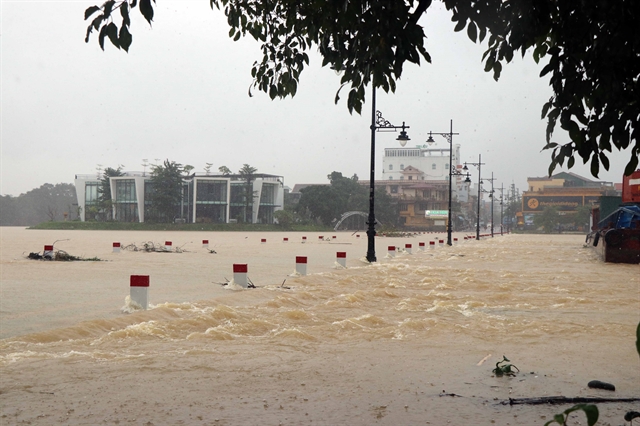 Society
Society


|
| Due to the impacts of the tropical depression (now the typhoon No 5), the water levels of rivers across Thừa Thiên-Huế has caused flooding alerts. — VNA/VNS Photo Đỗ Trưởng |
HÀ NỘI — The tropical depression over the waters off the central provinces of Quảng Trị and Quảng Nam have strengthened into a typhoon, becoming the fifth one in Việt Nam this year.
At 10am on Wednesday morning, the centre of the storm was located about 270km west-northwest of the Hoàng Sa (Paracel) islands and approximately 150km east of the Quảng Trị- Quảng Ngãi mainland.
The strongest winds reached force 8 (62-74km/h), with gusts up to force 11.
The typhoon is expected to move towards the Gulf of Tonkin in the north and weaken into a tropical depression in three days.
The central localities from Quảng Trị to Thừa Thiên-Huế provinces will experience heavy rainfall until Thursday morning, while downpours will start to bear down on the northern and the north-central region from Thursday night.
The National Steering Committee for Natural Disaster Prevention and Control on Wednesday issued a dispatch to its local offices in coastal provinces and cities from Quảng Ninh to Bình Định, urging them to closely monitor its development and started inspecting ships and vessels at sea as well as informing them of the typhoon's positions and pathways.
Local authorities should coordinate with specialised agencies, Border Guard Command, and local fisheries departments to instruct farmers on anchoring, sheltering, and protecting fishing vessels, aquaculture cages, and fish farms, as well as issue orders on prohibition marine activities if necessary to ensure the safety of people and property.
Mainland provinces and cities from Hà Tĩnh to Quảng Nam are told to watch out for flooding and landslides triggered by rainfall and to deploy rapid response teams to inspect and review riverside communities, low-lying areas, and be prepared to evacuate residents from areas at high-risk of flooding, landslides and soil erosion.
Local authorities are also instructed to review the safety of vulnerable coastal embankments and ongoing construction projects; implement flood control measures in urban areas and industrial zones; and inspect, review, and operate dams and reservoirs safely, especially small hydropower plants and vulnerable irrigation reservoirs. — VNS